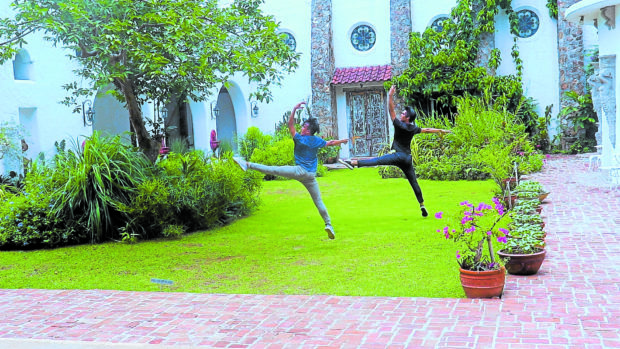
While performing arts companies worldwide have practically written off 2020 due to the pandemic, Ballet Philippines (BP) believes “the show must go on.”Since the Cultural Center of the Philippines is closed until December, the resident dance company launched its 51st season, titled “OnStream,” on the digital platform.
The website, ballet.ph, has videos of new works by guest artists, free live master classes by international artists, general interest stories and tips from the “Beautiful People”—resource persons outside of dance, a children’s section, a monthly streaming from BP’s repertoire and a dancer profile of the month.
Forty-five days after the lockdown, BP president Kathleen Lior-Liechtenstein and communications head Ping Valencia conceived of ballet.ph as the virtual stage for the company.
Web designer Amaia Garcia chose a classic but striking color theme of red, black and white for the graphics, while BP chair Antonio Cojuangco provided the web developer, TechCellar.
The board’s thrust for the 51st season is to reinvigorate the company with innovations and opportunities for the dancers to learn different dance styles and gain new perspectives from foreign artists. BP’s international creative team is led by the new artistic director Mikhail “Misha” Martynyuk, an Honored Artist of Russia, and guest artists Joseph Phillips, an American, and Joshua Serafin, a Filipino dancer-choreographer based in Belgium.
From July to September, 10 international teachers will give online classes pro bono. The public can join the classes for free by registering on the website. Instead of going public on Facebook or Instagram like other dance companies, this system will make it easier for guest teachers to monitor class participants.
With a core group of nine dancers, BP has been getting back on its feet. The company members follow a 9 a.m. to 5 p.m. schedule from Monday to Friday.
Working from Russia
Martynyuk, who is still in Russia, communicates regularly with Liechtenstein. No stranger to the Philippines, he was the partner of Lisa Macuja-Elizalde, Ballet Manila’s founder and CEO, in her final performances of “Don Quixote” and “Giselle.” His proudest achievement in the Philippines was the birth of his daughter at Makati Medical Center.
Martynyuk has always enjoyed his Manila visits. “The emotions of love for family, friends and country are very strong in the Filipino. I am Russian but I share this,” he said at the virtual press launch. His family is waiting for international travel to bear a semblance of normalcy so that they could finally come to the Philippines.
He sends 45-minute videos of calisthenics exercises as warmup for the daily online ballet classes, conducted by Phillips.
There are weekly master classes by the likes of Joy Womack, artist of the Boston Ballet and a Bolshoi alumna.
The afternoons are devoted to repertoire rehearsals with Phillips and improvisation sessions with Serafin.
To learn more about the dancers’ capabilities, Martynyuk devised a mini competition every month. A guest teacher will compose a movement combination, from which the BP dancers will choreograph and perform. They will video themselves and send them to Martynyuk and the guest teacher.
“By reviewing their videos, Misha can see their strengths and weak spots,” Liechtenstein told Lifestyle. “To get them motivated, there will be a prize of P10,000 each for the best male and female dancers of the month. It will add to their income. This is a trying time for everyone. At least, these dancers have something to look forward to.”
Beyond technique
At the virtual media launch, Phillips expressed his eagerness to perform again after losing 9 kilograms. He has danced classical lead roles for BP, Philippine Ballet Theater and Ballet Manila.
However, much of Phillips’ repertoire consisted of contemporary works by famous choreographers such as William Forsythe, Alexei Ratmansky and Wayne McGregor. “I’m excited to bring in contemporary work,” he said.
Phillips has also choreographed three works for BP and coproduced a fundraising dance video with American Ballet Theater principal Misty Copeland. Last summer, Liechtenstein sent Phillips a video of “The Swan Project,” which was performed by 24 cellists from different countries. She inspired him to develop it for dance. “Swans For Relief” is on BP’s website as one of its international projects which had engaged ballerinas worldwide, including BP’s Denise Parungao and Jemima Reyes, to interpret “The Dying Swan” solo. The donations are given to the participants’ companies.
While Phillips focuses on the classical technique, Serafin has been conducting exploratory studies on building a new movement expression for the BP dancers. His “method” focuses on “research” or making dances deeply personal rather than technique. He asks dancers to delve into every aspect of their body and meld their physicality into their psyche.
Liechtenstein said the dancers have been improvising in their homes based on such concepts as the “dystopian body.” Dancers explore what are dystopia and the effects of a lockdown such as constriction and disruptions leading to unemployment, hunger and uncertainty.
Prime mover
Serafin will present snippets of his work in July and August culminating in September. He will work with New York-based videographer Brandon Relucio. “We will strategize how to film from afar and work with the dancers’ conditions,” he said. In an interview with the Inquirer, Liechtenstein credited philanthropist and BP board member Mercedes “Dedes” Zobel as one of the prime movers of this season. She pushed for BP’s global outlook and helped in the search for a foreign artistic director. Zobel has seen Serafin’s arresting work abroad and recommended him for the 51st season.
Zobel also provided a grant which pays for the full salaries of the dancers.
“Nobody knows the future of ballet companies in the world under COVID-19 (new coronavirus disease). It’s an unchartered course. We can only continue dancing and training. For a dancer to stop during this time means losing the body form and the mental drive. We all need to be positive, work as one and embrace the ‘new normal,’” said Liechtenstein. —CONTRIBUTED INQ

